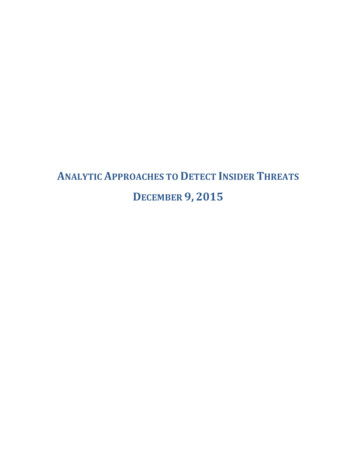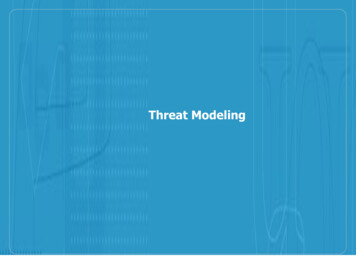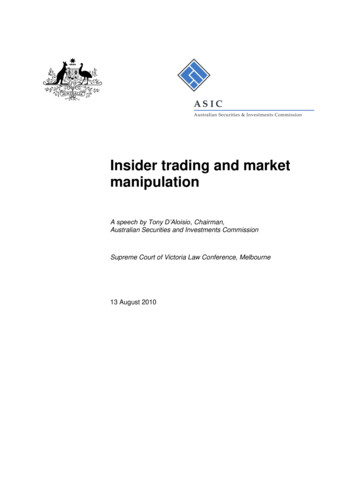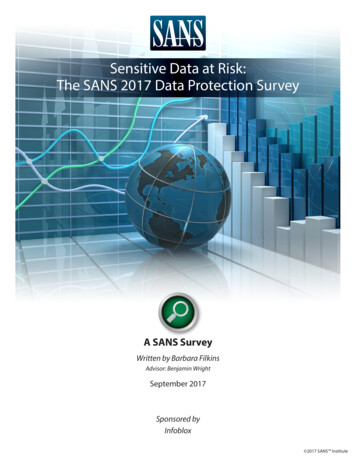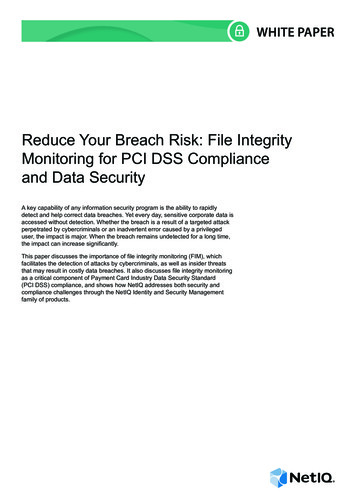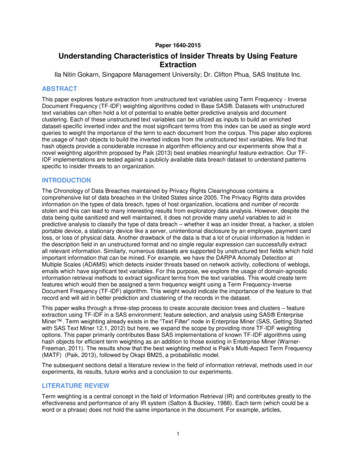
Transcription
Paper 1640-2015Understanding Characteristics of Insider Threats by Using FeatureExtractionIla Nitin Gokarn, Singapore Management University; Dr. Clifton Phua, SAS Institute Inc.ABSTRACTThis paper explores feature extraction from unstructured text variables using Term Frequency - InverseDocument Frequency (TF-IDF) weighting algorithms coded in Base SAS . Datasets with unstructuredtext variables can often hold a lot of potential to enable better predictive analysis and documentclustering. Each of these unstructured text variables can be utilized as inputs to build an enricheddataset-specific inverted index and the most significant terms from this index can be used as single wordqueries to weight the importance of the term to each document from the corpus. This paper also exploresthe usage of hash objects to build the inverted indices from the unstructured text variables. We find thathash objects provide a considerable increase in algorithm efficiency and our experiments show that anovel weighting algorithm proposed by Paik (2013) best enables meaningful feature extraction. Our TFIDF implementations are tested against a publicly available data breach dataset to understand patternsspecific to insider threats to an organization.INTRODUCTIONThe Chronology of Data Breaches maintained by Privacy Rights Clearinghouse contains acomprehensive list of data breaches in the United States since 2005. The Privacy Rights data providesinformation on the types of data breach, types of host organization, locations and number of recordsstolen and this can lead to many interesting results from exploratory data analysis. However, despite thedata being quite sanitized and well maintained, it does not provide many useful variables to aid inpredictive analysis to classify the type of data breach – whether it was an insider threat, a hacker, a stolenportable device, a stationary device like a server, unintentional disclosure by an employee, payment cardloss, or loss of physical data. Another drawback of the data is that a lot of crucial information is hidden inthe description field in an unstructured format and no single regular expression can successfully extractall relevant information. Similarly, numerous datasets are supported by unstructured text fields which holdimportant information that can be mined. For example, we have the DARPA Anomaly Detection atMultiple Scales (ADAMS) which detects insider threats based on network activity, collections of weblogs,emails which have significant text variables. For this purpose, we explore the usage of domain-agnosticinformation retrieval methods to extract significant terms from the text variables. This would create termfeatures which would then be assigned a term frequency weight using a Term Frequency-InverseDocument Frequency (TF-IDF) algorithm. This weight would indicate the importance of the feature to thatrecord and will aid in better prediction and clustering of the records in the dataset.This paper walks through a three-step process to create accurate decision trees and clusters – featureextraction using TF-IDF in a SAS environment; feature selection, and analysis using SAS EnterpriseMiner . Term weighting already exists in the “Text Filter” node in Enterprise Miner (SAS, Getting Startedwith SAS Text Miner 12.1, 2012) but here, we expand the scope by providing more TF-IDF weightingoptions. This paper primarily contributes Base SAS implementations of known TF-IDF algorithms usinghash objects for efficient term weighting as an addition to those existing in Enterprise Miner (WarnerFreeman, 2011). The results show that the best weighting method is Paik’s Multi-Aspect Term Frequency(MATF) (Paik, 2013), followed by Okapi BM25, a probabilistic model.The subsequent sections detail a literature review in the field of information retrieval, methods used in ourexperiments, its results, future works and a conclusion to our experiments.LITERATURE REVIEWTerm weighting is a central concept in the field of Information Retrieval (IR) and contributes greatly to theeffectiveness and performance of any IR system (Salton & Buckley, 1988). Each term (which could be aword or a phrase) does not hold the same importance in the document. For example, articles,1
conjunctions and other grammatical adages to a sentence appear extremely frequently in any documentbut usually do not hold any particular importance or significance in relation to that particular document.Calculating the importance of the term to the document involves three main characteristics: termfrequency in the document (TF), the inverse document frequency factor (IDF) and the document lengthnormalization factor (Manning & Raghavan, 2008). As a result of these three main factors, IR methodscan be essentially classified into three categories:1. Vector Space Models where both the document and the query on the document are consideredas a vector of terms2. Probabilistic Models where the probabilities of the existence of the query terms in the documentare calculated3. Inference based Models which instantiate a document with a weight and infer the query weightsin comparisonAll models have different strategies in tuning the precision and recall of the relevant terms. “In principle, asystem is preferred that produces both high recall by retrieving everything that is relevant, and also highprecision by rejecting all terms that are extraneous.” (Salton & Buckley, 1988). Term frequency (TF) aidsin retrieving all those terms which occur most frequently in the document and therefore acts as a recallenhancing factor.However, the term importance cannot be measured by counting the TF in that document alone, it alsorequires some comparison to the TF across all the documents in the collection in order to ensurerelevance and search precision of the term over the entire collection of documents. For this, the inversedocument frequency (IDF) which deals with the document frequency of terms is required. IDF ensuresthat high frequency terms which occur throughout all documents are not favored in an effort to increaseprecision for extremely specific words.Therefore, a reliable measure of term importance is obtained using a product of the term frequency andinverse document frequency commonly known as TF-IDF which ensures that the best words or terms arethose with high term frequencies and low document frequencies (Salton & Buckley, 1988). The TF-IDFweight assigned to a term aids in tuning both recall and precision, and this standard TF-IDF is the 1stmodel in our experiments.However, in IR, TF-IDF shows different behaviors over documents of varying lengths, as short queriestend to prefer short documents and long queries prefer long documents. In the past, a lot of research hasbeen contributed to finding the most effective weighting scheme to best normalize the weight of a term,particularly by Singhal et al (1996). The document length has a large effect in the term weight in twoways:1)Long documents use the same terms repeatedly leading to large term frequencies for certainterms.2)Longer documents have a larger number of terms. This increases the possible number ofmatches between the query and document during retrieval.Document normalization factors tend to penalize larger or longer documents in order to equalize thetreatment of both long and short documents over different query lengths. The most successful of allnormalization functions is the Pivoted Document Length Normalization suggested by Singhal et al (1996)and is the 2nd model to be evaluated in our experiment. This algorithm involves augmented normalizationwhich normalizes the TF against the maximum term frequency in the document and uses a parameter swhich acts as the pivoting factor between the probabilities of retrieval versus relevance.The 3rd algorithm is a novel TF-IDF weighting proposed by Paik (2013) where he observes that avariation in the parameter s from Singhal et al (1996)’s formula for Pivoted Document LengthNormalization leads to an imbalance while weighting terms against a mix of long and short documents.When the parameter s is set to a larger value, the algorithm prefers longer documents and when s is setto a smaller value the algorithm prefers short documents. Paik (2013) suggests that we take intoconsideration both short and long documents in order to not overcompensate shorter documents. Thepaper suggests Multi-Aspect Term Frequency (MATF), a product of an intra-document TF as well as a2
document length normalized TF. The proposed work asserts that the intra-document factor prefers shorterdocuments, and the length regularized factor favors longer documents, and a product of both with anappropriate weighting does not support one at the cost of the other. This leads to the creation of a moreaccurate model (Paik, 2013). He puts forth four hypotheses:1)TF Hypothesis: The weight of a term should increase with its TF but since it is unlikely tosee a linear relationship, we dampen the weight using a logarithmic transformation2)Advanced TF Hypothesis: The rate of change of weight of a term should decrease with alarger TF3)Document Length Hypothesis: It is necessary to regulate the TF with respect to thedocument length to avoid giving longer documents any undue preference4)Term Discrimination Hypothesis: If a query contains more than one word, the documentretrieved should be based on the rare term present in the query itself, indicating a need forweighting in the query alsoFor single worded queries, as is with our experiments, probabilistic models do exceedingly well and showmuch better accuracy than fully weighted vector models (Salton & Buckley, 1988). Therefore, we alsolook at a classic weighted probabilistic model and Okapi BM25, a state-of-the-art probabilistic modelmaking them our 4th and 5th model of interest respectively. An interesting observation is that Paik (2013)compared MATF to probabilistic models and noted better performance of MATF over Okapi BM25 so weare also interested in finding out if it held significance even for single word queries.METHODSHere, we discuss the methods in which the different weighting algorithms discussed in the LiteratureReview section are implemented in the SAS environment.Feature extraction can be carried out by individually evaluating each feature or term (univariate selection)and seeing their independent relevance to the dataset, which leads to ranked feature selection (Guyon &Elisseeff, 2007). This approach is generally considered efficient and effective, especially when dealingwith large numbers of extracted features as is with term extraction from a text variable. However, thisleads to two potential drawbacks due to the assumed independence between the extracted features:1)Features that are not relevant individually may become relevant in conjunction with otherfeatures2)Features which are individually relevant may actually be redundantTo overcome these drawbacks, we create the inverted index of all the unique terms in the entire datasetin Algorithm 1 ExtractInvertedIndex detailed below and construct all the features using TF-IDF weights inAlgorithm 2 CalculateTF-IDF. We then leave the feature selection and evaluation to pre-existingalgorithms in Enterprise Miner (SAS, Getting Started with Enterprise Miner 12.1, 2012). The constructedfeatures which are now regarded as inputs to the model are first clustered, then selected and evaluatedbased on information gain while building the decision tree in Enterprise Miner. The feature cluster whichgives the best split in the tree is selected and built on further. Clustering of the features mimicsmultivariate feature selection which makes simple assumptions of co-dependence of features or termsbased on their co-occurrence in the document corpus. This multivariate selection overcomes the twodrawbacks met when employing univariate selection.In Algorithm 1 ExtractInvertedIndex, we incorporate SAS hash objects to avoid complex PROC SQLsteps or the creation of numerous tables to compute term, document and collection frequencies(Eberhardt, 2010). In the first step, the documents are processed in sequence. At the beginning of adocument evaluation iteration, a document specific hash h1 is constructed and each term (as key) isstored along with the term frequency (as value) in that document. Once the entire document is stored intothe hash h1, we iterate through h1 and check if the term exists in the global hash h which stores thedocument frequency or the number of documents the term appears in over the entire corpus ofdocuments. If the term is there, we increment the document frequency by one, if not, we add the word tothe hash h. The global hash h is then stored in a table OUT using the hash object in-built function called3
output. The table OUT is then stripped of all stop words which are usually grammatical adages, articles,conjunctions, prepositions and such. The inverted index is then created by swapping the table OUT intoanother hash object which takes the document frequency as the key and the term as the value. Thisindex is then written out to another table called INDEX with the keys (document frequencies) sorted indescending order (SAS, Using the Hash Object, 2014). We also add a few words specific to PrivacyRights dataset to the stop list in an effort to remove all non-specific words or descriptions fromconsideration such as the words “specific”, “motive”, and “unknown” along with special non-ASCIIcharacters in the dataset.Algorithm 1 ExtractInvertedIndex1. Require: A dataset s with n variables V0,.,Vnof which Vx is anunstructured text variable, for example “Description”2. Ensure: Returns a dataset s with m observations, one for each termextracted from Description and two variables, the term and documentcount3. s dataset of n variables of which Vx is an unstructured text field4. h global hash object with key k as term and data value d as documentcount5. h1 local hash object with key k1 as term and data value d1 as termcount in that document6. initial j 17. word&j extract jth word from document8.do while word&j not equal to blank9.k1 word&j10.if k1 exists in hash h1 then11.d1 d1 112.end of if13.else14.add k1 to hash h1 and set d1 to 115.end of else16.j j 117.word&j extract word jth from document18. end of do while19. hiter iterator for document hash h120. do while hiter has next in hash h121.k next term in hash h122.if k exists in hash h then23.d d 124.end of if25.else26.add k to hash h and set d to 127.end of else28. end of do while29. table OUT to hold output of hash object h30. return OUT31. remove stopwords from table OUT32. h2 hash object with key k2 as document count and data value d2 asterm (inverted index)33. read contents of OUT into h2 sorted in descending order of documentcount34. table INDEX to hold output of hash h235. return INDEXTable 1: Algorithm 1 ExtractInvertedIndex4
The table INDEX which is obtained from the above piece of code contains two columns, documentfrequencies in descending order and their corresponding terms. As shown in Algorithm 2 CalculateTFIDF, once this index is created we select the top-30 terms by virtue of their document frequencies andadd them as features by turn to the original dataset assuming that 30 terms would allow for the creation ofan approximately sufficient feature subset. This number of features selected (e.g. 30 selected in thispaper) can be varied for different datasets in order to create approximately sufficient feature subsets.Then, for each feature added, we calculate the TF-IDF of the feature with respect to each document.Hence the exact calculation of TF-IDF differs over the weighting methods but the overall structure of thecode remains the same. The equation for each weighting function is detailed in in Exhibit 1: TF-IDF ModelEquations. The MATF algorithm only has a slightly different INDEX table that is generated – it contains anadditional column called collection frequency for each of the terms in addition to document frequency, inaccordance with the MATF model equation.Algorithm 2 CalculateTF-IDFRequire: A dataset s with n variables V0,.,Vnof which Vx is anunstructured text variable, for example “Description”; and dataset INDEXfrom Algorithm ExtractInvertedIndex with 2 variables of which every recordunder variable V2 is a featureEnsure: A dataset with n 30 variables of which Vn 1,.Vn 30 are features1. create table TEMP with top-30 words from INDEX2. &&n& number of records in TEMP as macro variable3. &&k&i ith feature from TEMP as macro variable4. &&d&i ith data value from TEMP as macro variable5. for all i 1 to &&n& with incremental counter of 16.initial j 17.word&j extract jth word from document8.initial this word count 09.initial total word count 010.do while word&j is not blank11.if word equal to feature &&k&i. then this word count this word count 112.total word count total word count 113.increase counter j14.word&j extract word jth from document15.end of do while16.if this word count 0 then17.tf calculate the term frequency18.idf calculate the inverse document frequency19.TF-IDF tf*idf20.&&k&i TF-IDF21.end of if22.else23.&&k&i 024.end of else25.end of i loop26.drop all unnecessary columns27.return sTable 2: Algorithm 2 CalculateTF-IDFAs observed by Paik (2013), models like Singhal et al (1996)’s Pivoted Document Length Normalizationmodel are very sensitive to change in the parameters used in the model equations that aid innormalization. Different tweaks in parameters yield different results. The baselines of the parametersused are elaborated below:5
1)Classic TF-IDF with no normalization: This model has no parameter but deviates from theclassic model where cosine normalization is used. This is because the document lengths inthe corpus in this particular dataset are fairly homogenous in length and therefore do notrequire much normalization2)Pivoted length normalization model: This model is a high-performing model in the vectorspace collection of models, the parameter s has been set to the default 0.05 (Singhal et al,1996)3)Best weighted probabilistic model: The augmentation factor has been set to the default0.5 although some research work has been done on the using a 0.4,0.6 pairing in normalizingthe term frequency (Manning & Raghavan, 2008)4)Okapi BM25: Whissell and Clarke found that out of the three parameters used in OkapiBM25, k1 should be higher than the default 1.2 as it leads to better clustering of thedocuments. Following this prerogative, we assign k1 the value 1.8 and b the default 0.75(Whissell & Clarke, 2011)5)Multi-Aspect TF-IDF (MATF): This model has a weighting factor w to balance out theweights of short and long queries on documents. Since we have only one word queries, weset w to 1 (Paik, 2013)The final dataset s is imported into Enterprise Miner for further analysis. The datasets are initially passedthrough the Variable Cluster node which reduces the dimensionality of the data, and also allows for someassumptions on co-dependence of the features based on co-occurrence in the dataset as detailed earlier.The data records are then partitioned into 60% towards training, 20% to training and 20% to testing. Next,the data is passed into the Decision Tree node where the selection criteria is set to Testing: ROC Index.The Receiver Operating Characteristic (ROC) curve is a visual method to compare classification models(Han, 2012). It gives the trade-off between true-positives to false-positives in the classification problemwhich means that the ROC curve depicts the ratio of the times the model has accurately classified apositive case versus the time the model has mistakenly classified a negative case as positive in a binarytarget scenario. The ROC Index or Area under the ROC curve gives the accuracy of the model using thetesting data (rather than the training data which tends to be over-fit).In the Decision Tree node in Enterprise Miner, all values are left to default except the handling of missingvalues where the documents with missing values are assigned to the most correlated branch.Additionally, all inputs or features selected by the tree during evaluation is allowed to be used only once,again to prevent over-fitting of the tree. A breakdown of the inputs are elaborated in Exhibit 2: DatasetVariables. The target variable is set to the breach type (variable “Type” in dataset).All the models are evaluated together and drawn into a single Model Comparison node to discern themost successful weighting algorithm based on the ROC Index. The entire model layout is depicted inExhibit 3: Enterprise Miner Model Layout.RESULTSHere we present the results of the Model Comparison node in Enterprise Miner as shown in Exhibit 3:Enterprise Miner Model Layout. Among all the results shown in Table 3: Results of TF-IDF Evaluations,we make the following key observations:1)The weighted probabilistic model does indeed perform much better than the fully weightedvector space models despite having pivoted document length normalization. This is attributedto the fact that we are using single word queries as opposed to complex multi-worded querieswhich themselves would also require weighting in the query (Salton & Buckley, 1988).2)Pivoted normalization model and the probabilistic model do not have very different resultsand so this does not attribute to the notion that probabilistic models are better for single wordqueries as compared to classic weighted models6
3)Raw term frequencies are usually not too indicative of the term importance and the moredampening the TF undergoes, the better the weighting model performs. This can be seen inthe following table as well, the more complex the term frequency component gets, the betterthe model performsModelTraining: ROC IndexTesting: ROC IndexValidation: ROC IndexNo TF-IDF0.5750.4340.598Classic TF-IDF0.6510.6610.516Pivotedlengthnormalization TF-IDF0.6860.5830.571Classic probabilistic0.6560.6810.543Okapi F)TF-IDFTable 3: Results of TF-IDF EvaluationsThe merits of feature extraction from an unstructured text field to support a dataset are evident uponobserving the nature of the decision tree. Based on the values obtained in the results table, we focus ourattention on the MATF model which seems to have the best performance among all weighting algorithms.There are three branches emerging from the dataset “TFIDF Modified” created by the MATF model:1)Original variables and features in the dataset are examined using StatExplore node2)A decision tree is built after clustering of the features3)The clusters in the data are explored using Segment Profiler nodeIn the StatExplore branch, we get a comprehensive view of the variables in the dataset and a breakdownof the target types against each variable. Table 4: Categorical Variables against Insider Threats gives usa view of how the variables interact with the target of Insider Threats. Out of all cities, New Yorkcontributes to 6.48% of all insider threats followed by 2.47% of the threats from Baltimore. The mostsusceptible are Medical Institutions and Government Departments in California and Florida on a statelevel and New York and Baltimore on a city level.VariableModeModePercentageMode 2Mode Percentage 2CityNew .19Type partments18.83Table 4: Categorical Variables against Insider ThreatsIn the decision tree branch, we first cluster the features in this dataset are divided into 11 major clustersas seen from the results of the Variable Clustering node shown in Exhibit 4: Variable Clustering Plot.Each upon closer observation indicate a specific component of a person’s identity, one variable clusterconcentrates on names and social security numbers, another cluster on medical records, another clusteron credit cards and so on. These clusters are used as inputs to the decision tree shown in Exhibit 5:Decision Tree generated from features built by Multi Aspect Weighting. We see that the most prominentbranch in the tree portrays that “Laptops”, “Stolen”, by/from “Employees”, “Contained” components ofpersonal identity. Non-Medical organizations saw more of a theft of “Social”, “Security”, “Numbers”whereas Medical Organizations saw more of an Insider Threat to records with a focus on “Birth”, “Dates”,7
“Names”, and “Addresses”. This insight is not discernable from a tree built without this feature extractionwhich only yields a tree with splits based on Entity or the kind of organization, city, state and number ofrecords breached.In the data clustering branch, we see 6 predominant data clusters as shown in Exhibit 6: ClusterSegments generated from features built by Multi-Aspect Weighting. The first significant cluster containsthose records which pertained to the theft of Social Security Numbers, Birth Dates and Addresses ofpeople but the cluster is characterized by the State in which the theft occurred and the total recordsstolen. The second cluster pertains to identity theft with the differentiating variable from the first cluster as“Employees” which could suggest that the breach was either carried out by employees or it affected onlyemployees. The third cluster pertains to identities exposed from laptops, the fourth cluster on credit cardand address information either accessed or exposed, the fifth cluster on medical records being breached.The final sixth cluster is on people being affected by a breach in medical institutions, which is by far themost sensitive and frequent kind of breach particularly perpetuated by insiders to the institution. Theseclusters give a rather clear picture of the characteristics of the main types of clusters in the data. Incomparison, the original dataset without extracted features produces clusters based only on the Entity orthe kind of organization which suffered the breach which are not too informative, as seen in Exhibit 7:Cluster Segments generated from original dataset. These insights allow organizations to betterunderstand the characteristics of insider threats and data breaches.FUTURE WORKThe term weighting algorithms implemented in Base SAS can be improvised and further strengthenedusing a variety of mechanisms which aid in better extraction. The building of the inverted index as inAlgorithm “ExtractInvertedIndex” can be done based on a taxonomy as is in the Text Parsing node inEnterprise Miner in order to further filter out those words which are truly significant to the documents.Similarly, Algorithm “CalculateTF-IDF” can have a fourth part in addition to term weighting, documentweighting and length normalization which could be a relevance feedback mechanism that will guide thealgorithm during extraction. Such a feedback mechanism is suggested in variations of Okapi BM25(Manning & Raghavan, 2008). Finally after all the features have been constructed, other forms ofdimensionality reduction can be used instead of Variable Clustering, like Single Value Decomposition(SVD) in order to build text topics which would then carry a collective weight of all the terms in that topic.A novel way to add on to the existing term weighting algorithms would be by integrating a Google Searchwith every record or event. Cimiano and Staab (2004) proposed “Searching by Googling”, a novel way toadd on to individual knowledge by drawing on the community using Google API in order to overcomeknowledge acquisition bottlenecks and to strengthen the meta-data of any dataset. They suggestedPANKOW (Pattern based Annotation through Knowledge on the Web) which would build lexical patternsindicating a semantic or ontological relation and then would count their occurrences using Google APIthereby giving another measure of weight to the record itself (Cimiano & Staab, 2004). The datasetevaluated in this paper has more of high level information and therefore exact details for each recordcannot be ascertained. However, the same term weighting algorithms can be run on network or accesslogs obtained by an organization to help in feature extraction, from which insider threats can be detectedwhen comparing the extracted patterns to an existing black list of known scenarios.CONCLUSIONIn this paper, we propose SAS TF-IDF implementations using hash objects which aid in efficient featureextraction from unstructured text variables. These term weighting implementations are then evaluated inSAS Enterprise Miner by building decision trees comprising of the selected features. The ROC index(AUC) obtained from the testing dataset is used to choose the preferred model of feature weighting. Ourexperiments show the Multi-Aspect Term Frequency (MATF) proposed by Paik (2013) to be the bestperforming term weighting function and the decision tree built upon these features with MATF weightingproves to be insightful and gives a clear picture of the nature of data breaches conducted by anorganization’s own employees.8
APPENDICESEXHIBIT 1: TF-IDF MODEL EQUATIONSModelEquationClassic TF-IDF 𝑇𝐹. 𝑙𝑜𝑔𝑡 𝑞 𝐷Pivoted lengthTF-IDFnormalization𝑁𝐷𝐹(𝑡, 𝐶)1 ln(1 ln(𝑇𝐹(𝑡, 𝐷)))𝑁 1. 𝑇𝐹(𝑡, 𝑄) . 𝑙𝑛𝑠. 𝑑𝑜𝑐𝑙𝑒𝑛(𝑡, 𝐶)𝐷𝐹1 𝑠 𝑡 𝑄 𝐷𝑎𝑣𝑔𝑑𝑜𝑐𝑙𝑒𝑛 Classic probabilistic 0.5 𝑡 𝑞 𝐷Okapi BM25 𝑙𝑜𝑔𝑡 𝑄 𝐷Multi-Aspect TF-IDF0.5 . 𝑇𝐹(𝑡, 𝐷)𝑁 𝐷𝐹(𝑡, 𝐷). 𝑙𝑜𝑔𝑀𝑎𝑥𝑇𝐹(𝑡, 𝐷)𝐷𝐹(𝑡, 𝐷)𝑁𝑇𝐹(𝑡, 𝐷). (𝑘 1).𝐷𝐹(𝑡, 𝐷) 𝑇𝐹(𝑡, 𝐷) 𝑘. ((1 𝑏) 𝑏. 𝑑𝑜𝑐𝑙𝑒𝑛 )𝑎𝑣𝑔𝑑𝑜𝑐𝑙𝑒𝑛 (𝑤. 𝐵𝑅𝐼𝑇𝐹 (1 𝑤). 𝐵𝐿𝑅𝑇𝐹). 𝐼𝐷𝐹(𝑡, 𝐶).𝑡 𝑞 𝐷𝐴𝐸𝐹(𝑡, 𝐶)1 𝐴𝐸𝐹(𝑡, 𝐶)However, since w 1, (𝐵𝑅𝐼𝑇𝐹). 𝐼𝐷𝐹(𝑡, 𝐶).𝑡 𝑞 𝐷Where BRITF BLRTF 𝑅𝐼𝑇𝐹1 𝑅𝐼𝑇𝐹𝐿𝑅𝑇𝐹 (𝑡,𝐷)𝐴𝐸𝐹(𝑡, 𝐶)1 𝐴𝐸𝐹(𝑡, 𝐶);RITF 𝑙𝑜𝑔2 (1 𝑇𝐹(𝑡,𝐷))1 𝑙𝑜𝑔2 (1 𝐴𝑣𝑔𝑇𝐹(𝑡,𝐷)); LRTF TF(t,D).𝑙𝑜𝑔2 (1 1 𝐿𝑅𝑇𝐹(𝑡,𝐷)IDF 𝑙𝑜𝑔10𝑁𝐷𝐹(𝑡,𝐶); AEF Where,t termD documentC collection of documents (corpus)N number of documents in ���)𝑑𝑜𝑐𝑙𝑒𝑛)
Q queryTF term frequencyDF document frequencyMaxTF Maximum term frequencyCollectionTF Collection term frequencydoclen Document lengthavgdoclen
This paper walks through a three-step process to create accurate decision trees and clusters - feature extraction using TF-IDF in a SAS environment; feature selection, and analysis using SAS Enterprise Miner . Term weighting already exists in the "Text Filter" node in Enterprise Miner (SAS, Getting Started


